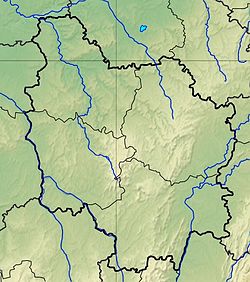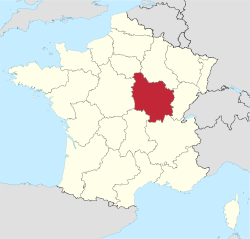Dijon Airport
Dijon-Longvic Air Base Base aérienne 102 (Advanced Landing Ground Y-9) |
|||||||||||||||
|---|---|---|---|---|---|---|---|---|---|---|---|---|---|---|---|
| Summary | |||||||||||||||
| Airport type | Military | ||||||||||||||
| Owner | Government of France | ||||||||||||||
| Operator | Armée de l'air | ||||||||||||||
| Serves | Dijon, Bourgogne, France | ||||||||||||||
| Location | Longvic, France | ||||||||||||||
| Elevation AMSL | 726 ft / 221 m | ||||||||||||||
| Coordinates | 47°16′26″N 005°05′20″E / 47.27389°N 5.08889°ECoordinates: 47°16′26″N 005°05′20″E / 47.27389°N 5.08889°E | ||||||||||||||
| Website | aeroport.dijon.cci.fr | ||||||||||||||
| Map | |||||||||||||||
| Location of airfield in Burgundy region | |||||||||||||||
| Runways | |||||||||||||||
|
|||||||||||||||
|
Source: French AIP and airport website
|
|||||||||||||||
Dijon-Longvic Air Base (French: Base aérienne 102 Dijon, IATA: DIJ, ICAO: LFSD) is a former French Air Force (French: Armée de l'Air) air base. The base is located approximately 2 miles (3.2 km) east-southeast of Longvic; about 165 miles (266 km) southeast of Paris. It was closed on June 30, 2016, after 102 years of existence.
Dijon-Longvic Air Base is one of the oldest of the Armée de l'Air, being established in 1914, having origins beginning in September 1910 as a civil airdrome. It has been active for over 95 years, through both 20th Century World Wars, the Cold War, and numerous crises. The military will withdraw from the base under budget cuts announced in October 2014.
Operating as a joint civilian base, it is also a commercial airport.
Dijon Air Base is one of the oldest of the Armée de l'Air, being established in 1914, having origins beginning in September 1910 as a civilian aerodrome.
In the years following the sumptuous "aviation parties" that were held in Dijon (from 22 to 25 September 1910), the French War Department decided to build a military airfield near the city, and on 7 July 1913, nine hectares located between the villages of Ouges and Longvic, near the National Road 468, were declared of public utility.
This airfield became operational in the spring of 1914 and was assigned the headquarters of the 1st Aviation Group, which was accommodated in several aircraft hangars and barracks. Four squadrons were stationed there when the World War broke out: the BR 17, BL 18, HF 19 and MF 20. It is on this military airfield that the 2e reserve aviation unit dedicated to the centralization of deliveries made ??by factories working for the aviation and transit to aviation squadrons of the parks from the front of the stored goods. 2Y also worked, from 1917, a flight school dedicated to piloting aircraft Voisin firm. On May 13, 1916, there was presented to the troops the flag of the Air Force by the most famous aces of war, Lieutenant Guynemer injured two months earlier at Verdun-bearer in front of the front of the troops of 1st group.
After 1919, Dijon-Longvic was used for deployment of several units specializing in pursuit and observation. In 1920, saw the birth of Dijon 2e observation aviation regiment equipped with Breguet 14 (renamed later 32nd RAO). That same year, on the edge of the airfield, an area was reserved for civil aviation and the land became "mixed aerodrome". Civil aviation was built near the future base 102, at the northern end of the coast and southwest of Dijon, aeronautical lighthouse great power of Mt. Africa, situated on the air route Paris-Lyon-Marseille.
...
Wikipedia


